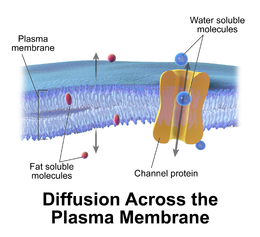
Back نقل سلبي Arabic Pasivni transport BS Transport passiu Catalan Transporte pasivo Spanish Transport passif French Transpò pasif HT Passzív transzport Hungarian Transpor pasif ID Trasporto passivo Italian 受動輸送 Japanese
This article needs additional citations for verification. (November 2022) |

Passive transport is a type of membrane transport that does not require energy to move substances across cell membranes.[1][2] Instead of using cellular energy, like active transport,[3] passive transport relies on the second law of thermodynamics to drive the movement of substances across cell membranes.[1][2][4] Fundamentally, substances follow Fick's first law, and move from an area of high concentration to an area of low concentration because this movement increases the entropy of the overall system.[4][5] The rate of passive transport depends on the permeability of the cell membrane, which, in turn, depends on the organization and characteristics of the membrane lipids and proteins.[citation needed] The four main kinds of passive transport are simple diffusion, facilitated diffusion, filtration, and/or osmosis.
Passive transport follows Fick's first law.
- ^ a b "5.2 Passive Transport - Biology 2e | OpenStax". openstax.org. 28 March 2018. Retrieved 2020-12-06.
- ^ a b "5.2A: The Role of Passive Transport". Biology LibreTexts. 2018-07-10. Retrieved 2020-12-06.
- ^ "5.3 Active Transport - Biology 2e | OpenStax". openstax.org. 28 March 2018. Retrieved 2020-12-06.
- ^ a b Skene, Keith R. (2015). "Life's a Gas: A Thermodynamic Theory of Biological Evolution". Entropy. 17 (8): 5522–5548. Bibcode:2015Entrp..17.5522S. doi:10.3390/e17085522.
- ^ "12.7 Molecular Transport Phenomena: Diffusion, Osmosis, and Related Processes - College Physics for AP® Courses | OpenStax". openstax.org. 12 August 2015. Retrieved 2020-12-06.
© MMXXIII Rich X Search. We shall prevail. All rights reserved. Rich X Search